Tunisian Street Food Guide: 18 Best Street Eats To Try 2024
Before going to Tunisia, I really didn’t know what to expect to find there in terms of food. Would it be like Egypt or Morocco? I love trying street food, so I was excited to jump in. When I did, I was pleasantly surprised.
I have created this guide to the 18 best Tunisian street foods to try so you can get your mouth salivating even before you arrive.
Tunisian Street Food
Tunisians, like me, love spicy food, so it was a food palette match made in heaven. Tunisians add harissa (a spicy sauce) to nearly every dish. Don’t worry, if you don’t like spicy (picant), you can usually get it without the harissa too.
While Tunisian food varies quite a bit, there are still a few very common ingredients that you’ll see repeated again and again: Tuna, black olives, hard-boiled egg, potatoes, and of course, harissa.
Tunisian food has a lot of connections with other cultures. Due to the expansiveness of the Ottoman Empire, you can find lots of similar words and food in modern-day Turkey. Due to its proximity to the Mediterranean Sea, Tunisian food is also influenced by other coastal countries such as Lebanon and Italy. And of course, due to its previous occupation by France, you’ll find lots of good bread and baguette options. Many of Tunisia’s main staples are also deeply influenced by the Jewish community, mainly concentrated on Djerba Island.


NickiPostsTravelStuff.com contains affiliate links and is a member of the Amazon LLC Associates Program. If you make a purchase using one of these Amazon.com links, I may receive compensation at no extra cost to you. Read the disclaimer for more information. I only recommend products that I believe in.
Going to Tunisia soon? Get Ready at a glance:
Get travel medical insurance with SafeyWing.
Book your stay with Booking.com.
Check Flights with Skyscanner or Hopper.
Rent a car with RentalCars.com.
Download the Airalo app and get a Tunisian eSIM.
Take a tour with GetYourGuide or Viator.
Have a 1:1 consultation with me in advance!
10 Best Tunisian Street Foods
You can find incredible street food all over Tunisia, but the best place to start is the country’s capital city, Tunis. You can find good smells around every corner as you wander through the medina of Tunis, and the seaside neighborhoods of La Goulette, Sidi Bou Said, and La Marsa.
Prices are always the most expensive at restaurants aimed at tourists such as Café des Délices in Sidi Bou Said, Dar el Jeld in the Tunis medina, and Au Bon Vieux Temps in Lar Marsa, etc. While those restaurants are delicious, I had the most fun exploring the more local spots around the city such as the pedestrian street in La Marsa (photo below), and the small alleyways in and around the medina.
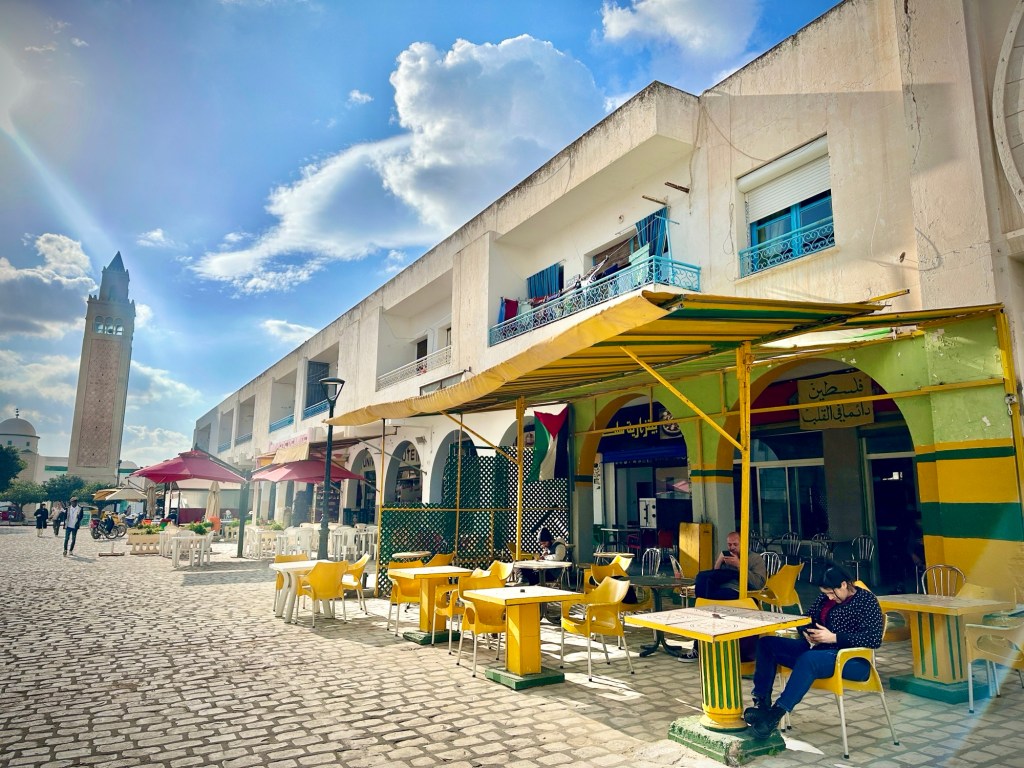
1. Fricassé
Fricassé (pron: free-ka-say) was the first Tunisian street food I tried. I walked down the pedestrian road in the La Marsa neighborhood in Tunis and saw a line of people eating something. I got the courage to ask a woman in my basic French what she was eating and where I could find it. She pointed me to Chez L’Ami Mustapha in La Marsa where I was greeted with a big, kind smile.
I watched as the man there added tuna, potatoes, egg, and olives to a small fried bread. He asked if I wanted it picant, spicy. Oui! When I paid my 1 TND (.30 USD) and took my first bite, I knew I would love Tunisian food. I went back to that same stand several times.
Fricassé was created in the 1800s by the Jewish community in Tunisia. The myth is that a Jewish woman first invented the fricassé as she had an abundance of dough but no sugar. So, she filled her would-be sweet donuts with savory ingredients instead.
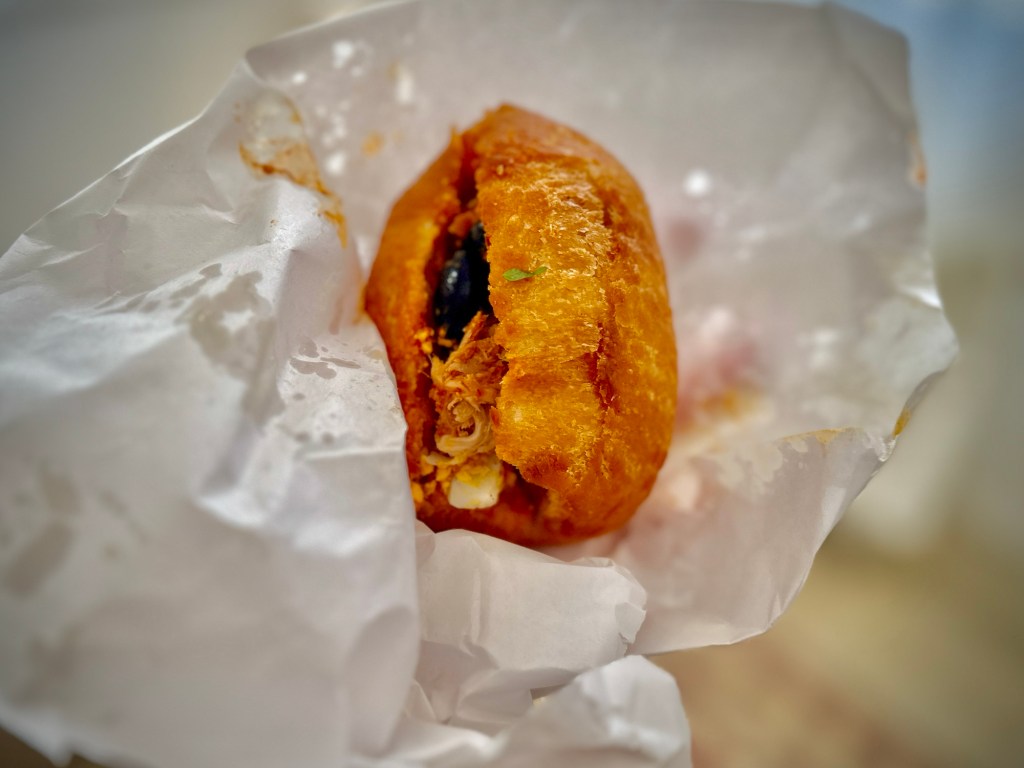
Ingredients: fried bread, tuna, potatoes, black olives, egg, harissa, parsley
Spice level: medium (but you can choose)
Average cost: 1-3 TND
The best place to try it: Chez L’Ami Mustapha in La Marsa
2. Brik
You can find brik (pron: breek) at nearly any fast food stand around Tunisia. It is mainly fried dough with tuna, potatoes, and egg inside. The latter is the main star. With your first bite of brik, the goal is to find the runny egg and drink the juices.
Brik is said to have originated in the south of the country, most likely Djerba Island, where the majority of the Jewish community in Tunisia lives. However, the word ‘brik’ resembles the word ‘borek,’ which is a delicious Turkish pastry. They likely share an origin story dating back about 500 years.


Ingredients: filo dough fried, egg, potatoes, parsley, capers, and sometimes tuna
Spice level: low
Average cost: 3 TND
Best place to try it: Chez L’Ami Mustapha in La Marsa
3. Kafteji
While kafteji (pron: calf-teh-jee) is full of vegetables, they are all deep-fried before being mixed together to create this commonly eaten traditional food in Tunisia. Kafteji can be eaten as a dish by itself served with an egg on top and potatoes on the side, or as a sandwich, with the veggie mix packed into a baguette with an egg on top. I prefer the sandwich if I had to choose.
Kafteji is another Tunisian food with shared Turkish roots. The word “kafteji” comes from the Turkish köfteci, which means “seller of kofta.” Kafteji is #1 in TasteAtlas’s list of the Top 6 Maghrebi Vegetable Dishes. This is one of the most well-known dishes in Tunisian cuisine.


Ingredients: zucchini, squash, tomato, potato, chili peppers, eggs, harissa, salt and pepper
Spice level: medium
Average cost: 5-8 TND
The best place to try it: Chez Hattab or Oueld El Bey in La Marsa
4. Lablebi
Lablebi (pron: lob-leh-bee) might be the most intimidating Tunisian street food to try for the first time, only because there are a few steps involved. When you’re new to Tunisia, you would have no clue how to start, so I’m going to help you out here.
When you first order lablebi, they will give you a bowl and a stale baguette. Take that baguette and tear it up into small pieces in the bowl. Once your bowl is filled with small bread chunks, take it back up to the window where they will add chickpeas, broth, meat if you want it, an egg, spices, and harissa. The last step is to take two spoons, one in each hand, and mix it all up until it looks like a thick bready stew. Then eat.
While it is most commonly eaten as a stew, you can also find it in sandwich form. The city of Bizerte is well known for the lablebi sandwich, which you can find on nearly every corner for about 3 TND.
Lablebi is another Tunisian food that shares its roots with the Turkish language. Leblebli in Turkish means “roasted chickpeas.” These Turkish connections stem from the 16th century, when the Ottoman Empire controlled parts of the Maghreb, including Tunisia. The legend is that lablebi was served to the Ottoman soldiers as it was both easy and cheap to prepare for the masses.


Ingredients: chickpeas, stale bread, egg, cumin, salt, pepper, tuna, harissa, tuna/meat (optional)
Spice level: medium to high (you can choose spice level)
Average cost: 8-10 TND for lablebi bowl; 3 TND for lablebi sandwich
The best place to try it: Chez Hattab in La Marsa; the lablebi sandwich is famous in Bizerte.
5. Chevrette
Chevrette (pron: shev-rette) are tiny shrimp that can be found served alone as an appetizer, or between two pieces of bread on a sandwich. The name chevrette in French means “doe,” but is very similar to the French word crevette, which means shrimp.
The best chevrette sandwich I found was in a small food stall in the Medina of Tunis called Ka ya fast-food.


Ingredients: mini shrimp, cheese, onion, peppers, tomatoes
Spice level: low-medium
Average cost: 6-8 TND
Best place to try it: Ka ya fast-food in the Medina of Tunis
6. Makloub
You can find a makloub (pron: mock-loob) sandwich in almost any corner of Tunisia. It is a sandwich made with pizza dough, then folded over with vegetables, meat (usually chicken), mayonnaise, and of course harissa inside. It is often served with potatoes or french fries on the side.
One of the better makloubs I ate was in the Medina of Tunis at a small restaurant in the covered alleyway full of cafes.

Ingredients: pizza bread, harissa, mayonnaise, chicken, lettuce, onion, peppers, cucumbers, ricotta cheese
Spice level: medium – high
Average cost: 7-8 TND
Best place to try it: You can find several stands in the Medina of Tunis
7. Baguette Farcie
A Baguette Farcie (pron: bag-ette far-see) is a sandwich that is baked all at once. The meat and vegetables are laid out over a raw piece of dough. The dough is then folded over the inside ingredients, covering them completely, then baked in an oven.
While it may seem like a simple bread, the baguette actually has a history of political turmoil in Tunisia. The French colonized Tunisia in 1881 and began forcing farmers to plant soft wheat instead of hard wheat, which resulted in a large production and consumption of baguettes. As workers no longer had time for lengthy meals, fast food became more common, and with it, the baguette was quick and easy to prepare and eat.
The baguette also became a symbol of the Arab Spring that began in Tunisia in 2011. As prices of items rose, including wheat, Tunisians began to suffer under the weight of inflation. They brought baguettes to the protests to symbolize the demand for dignity and a better quality of life.
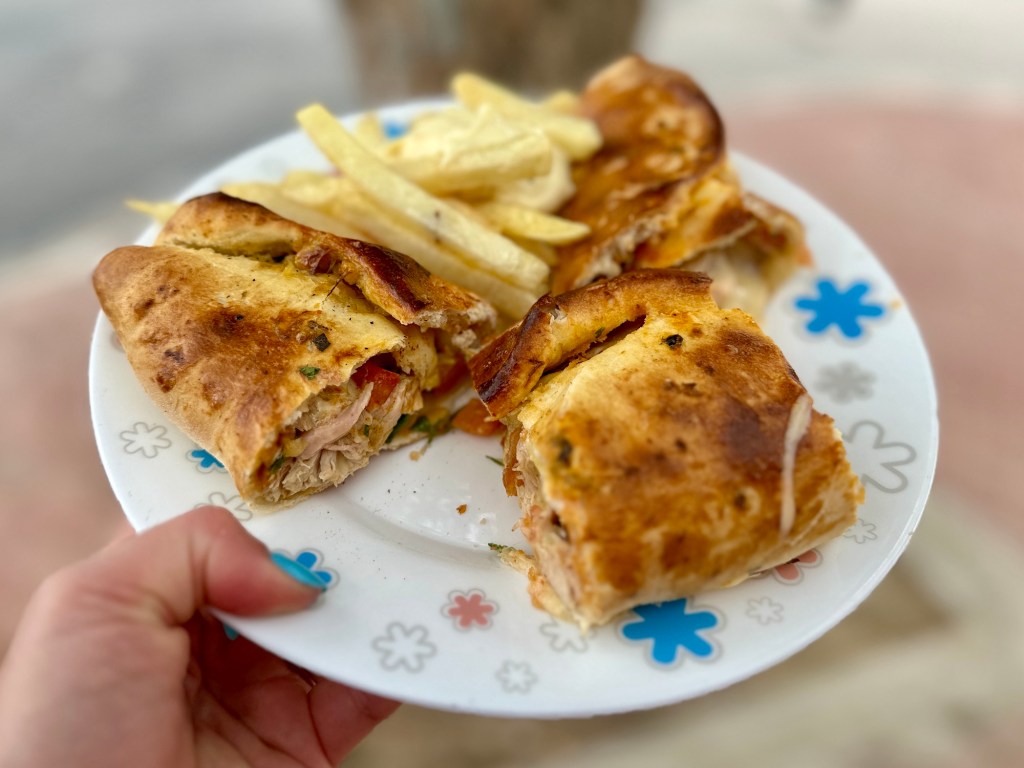
Ingredients: baguette, chicken, cheese, onion, harissa, oregano
Spice level: low – medium
Average cost: 7-8 TND
Best place to try it: Food stalls in the Medina of Tunis or Am El Matri in Carthage
8. Mlawi
Mlawi (pron: meh-lau-wee) is a type of sandwich wrap in Tunisia that is made from flatbread, filled with ingredients (harissa, cheese, egg, meat, veggies), and eaten like a burrito. It is very similar to the msemen in Algeria, Lebanon, or Morocco.
The mlawi is one of my favorite Tunisian foods and can be found anywhere around the country from Tunis to Sousse to Tatouine.


Ingredients: Tunisian flatbread, meat, onions, tomatoes, other veggies
Spice level: low to medium
Average cost: 6-8 TND
Best place to try it: In La Marsa or the Medina
9. Escalope
Escalope (pron: ess-call-ope) is less a type of food and more a way to cook meat. However, you will often see “escalope” listed on a restaurant’s menu. Making escalope involves beating the meat (usually chicken or lamb) until it is very flat, then frying it. You can get escalope in several sandwiches such as mlawi or makloub. You can also order a plate of escalope which is usually served with a salad and french fries.
Note: Escalope is NOT scallops (the seafood), even though the name is similar. It is a common misconception when traveling in Tunisia for the first time.
Escalope is eaten all over the country, though the best escalope plate I had was in a small fast-food restaurant in the city of Tataouine called Pizzeria Lela Meriem.


Ingredients: meat pounded and fried
Spice level: zero
Average cost: 10-12 TND
The Best place to try it: Pizzeria Lela Meriem in Tatouine
10. Tajine
While Tajine (pron: tah-jean) is originally a Moroccan dish, it can be found all across the Maghreb region, including both Tunisia and Egypt. The tajine is a 2-piece cooking pot made of red clay. The bottom piece is a flat dish where you put the food, and the top piece is like a large cone-shaped chimney with a hole on top. It is like a North African crock pot in a way.
You add the items, usually potatoes, carrots, and meat, cover, and cook for a few hours. Very little water is needed in this cooking method, as the steam from the food gets trapped in the cone, condenses, and returns to the food.
The tajine is said to originate from the nomadic Berber tribes in North Africa. I had a traditional tajine at Cafe Seles, which is one of the best restaurants in Tunisia, and the highest rated in Sousse.
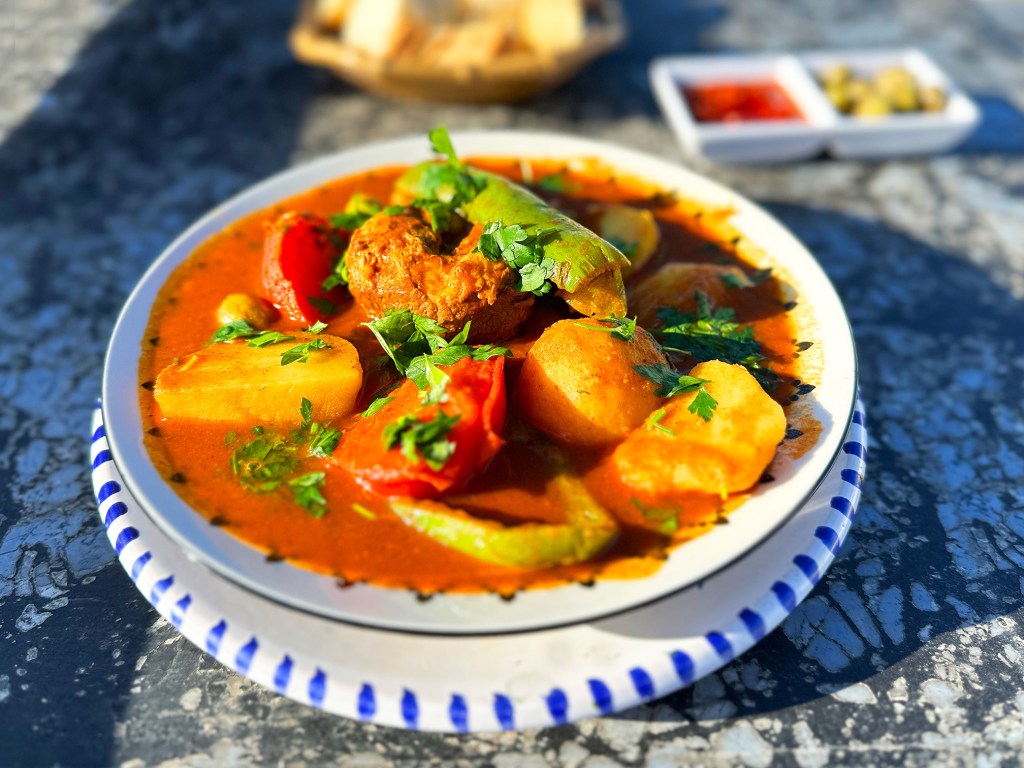
Ingredients: meat, potatoes, tomatoes, carrots, herbs
Spice level: medium
Average cost: 15-18 TND
The best place to try it: Restaurant Cafe Seles in Sousse has the best I’ve tried
11. Couscous
Couscous (pron: koos-koos) is Tunisia’s national dish, which is said to have originated with the nomadic Berber peoples of North Africa in the 7th century. It is like a tiny pasta made with semolina flour. The Berbers of Tunisia were grain collectors and stored their grains in structures called ghorfas, which can be found all over southern Tunisia. These structures were even the inspiration for Tatouine in Star Wars.
When you order couscous in Tunisia, you should expect very large portions. The couscous is often served with a type of meat, large beans, carrots, onions, and herbs.

Ingredients: couscous, carrots, meat, onions
Spice level: medium
Average cost: 8-10 TND
Best place to try it: The food area around La SafSaf in La Marsa
12. Salade Mechouia
The Slata Mechouia (pron: meh-sho-ee-ah) is TasteAtlas’s number 2 salad in a list of the Top 100 Salads in the world. It is a mix of tuna, onions, tomatoes, garlic, peppers, jalapeño peppers, egg, olives, and oil. I have tried it both on top of lettuce, as well as on top of bread.
You will find the Salade Mechouia at a very high price (around 28 TND) at restaurants in Sidi Bou Said, but you can also find it at much more affordable prices (6 TND) at smaller local restaurants. Salade Mechouia is often served as a side dish to a main meal, and it is more popular in the summer than in winter.
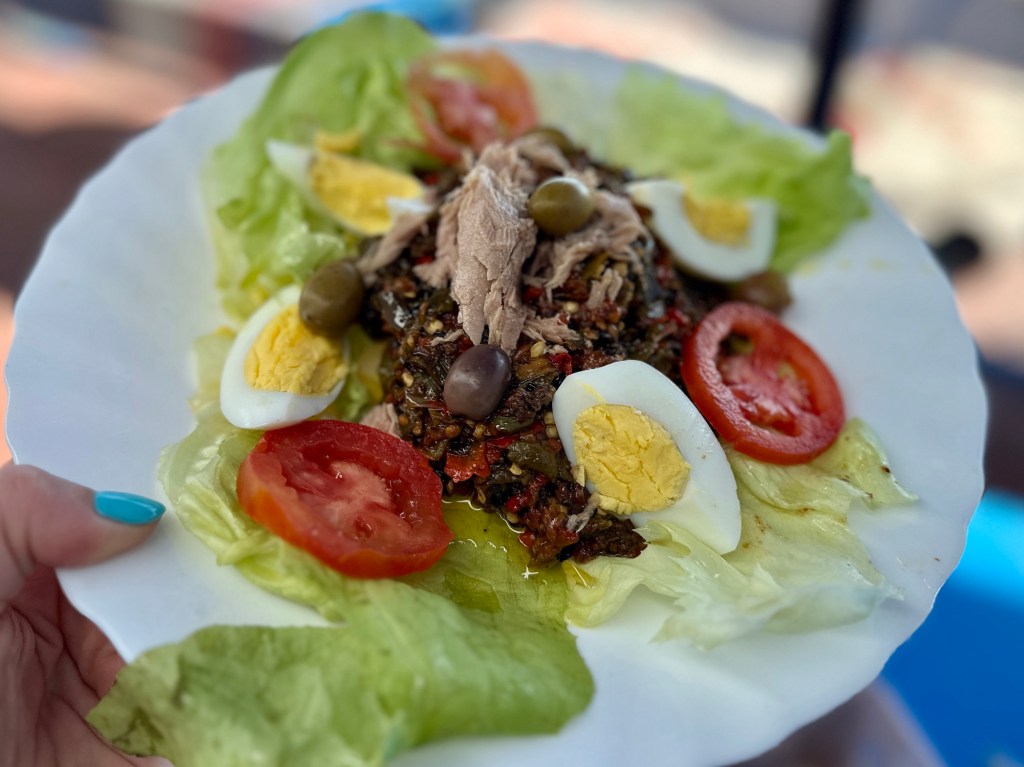
Ingredients: tuna, onions, tomatoes, garlic, peppers, jalapeño peppers, egg, olive
Spice level: low to medium
Average cost: 6-10 TND
Best place to try it: Restaurants near La SafSaf
13. Bambaloni
While I generally prefer savory treats, the bambaloni (pron: bomb-bah-loh-nee) is one of my favorite Tunisian street foods. You can smell it walking down the street in Sidi Bou Said, La Marsa, or any medina of Tunisia. The bambaloni is a fried circle of dough, like an empty shell of a donut, covered in sugar. When it is warm and fresh out of the fryer, it is spectacular.
Because of Tunisia’s proximity to Italy, the influence on one another is inevitable. The word bambaloni comes from a similar Italian word that means “donut” – bomboloni. Not only is this one of Tunisia’s best desserts, it is also incredibly affordable, usually costing about 1 TND (.30 USD).
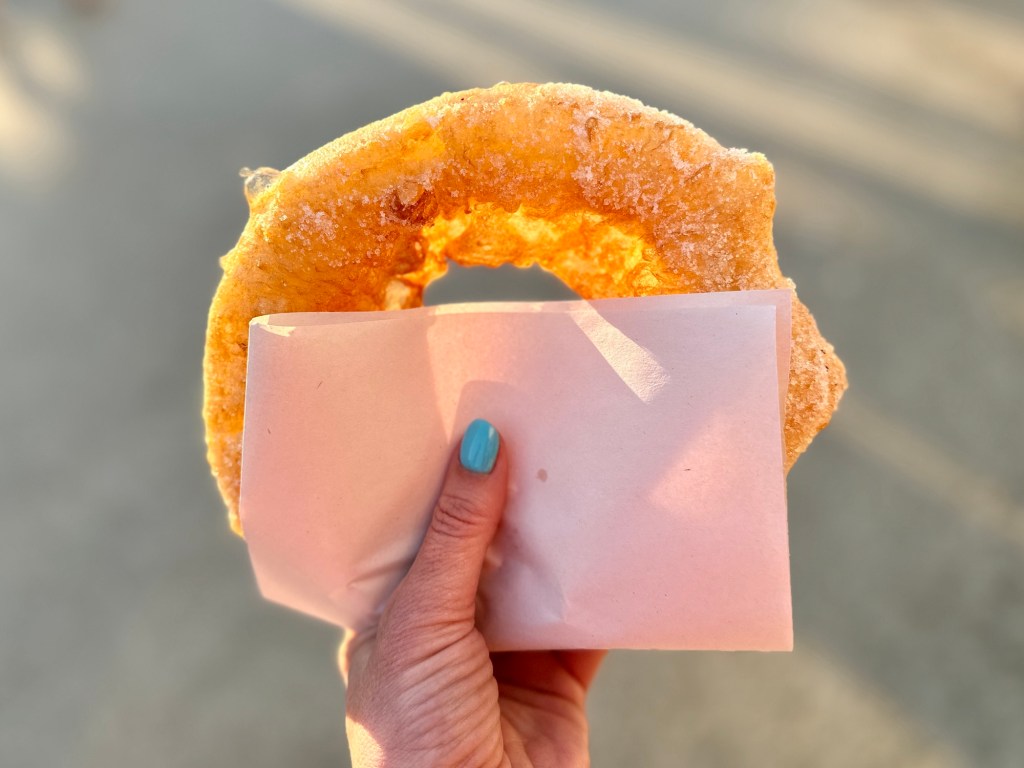
Ingredients: fried dough, sugar
Spice level: zero
Average cost: 1-3 TND
Best place to try it: Food stalls near La SafSaf, Tunis Medina, Sousse Medina
14. Makroudh
The makroudh (pron: mah-kroo-dth) is a Tunisian cookie that can be found around every corner of Tunisian medinas, though it originated in Kairouan. In Arabic, makrout means “diamond shape,” which is very fitting. While it is technically a cookie, makroudh doesn’t tend to be overly sweet, which I appreciate.
Makroudh are made with dates, almonds, or peanuts, then fried or baked, and dipped in honey or sugar syrup. These Tunisian cookies are usually priced by weight. I found that the makroudh in Kairouan was the most expensive, and the ones found in the medina of Tunis were the most affordable.


Ingredients: semolina, dates, nuts, honey, cinnamon, sugar, toasted seeds
Spice level: zero
Average cost: 8-20 TND for a small box
Best place to try it: Kairouan, Tunis Medina
15. Zalebia and Makharak (Ramadan Sweets)
Zalebia (pron: zah-LEB-ya) and makharak (pron: mah-KHA-rock) are Tunisian Ramadan foods. It is rare to find them outside of the month of Ramadan. I found them in several small shops in Kairouan during Ramadan.
Zalebia is the circular Ramadan treat, and makharak is the stick-shaped treat. The spiral zalebia is not only popular in Tunisia but in India, Bangladesh, and other countries in the Maghreb. It is a fried dough dipped in a sugar syrup, and tastes a bit chewy.
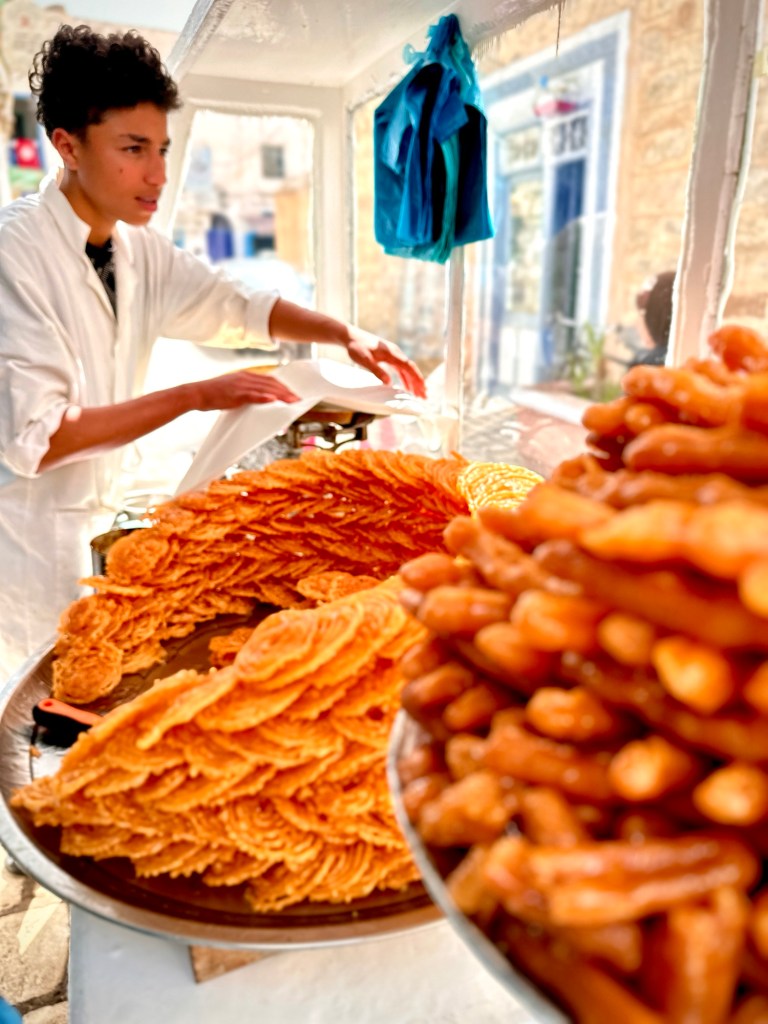
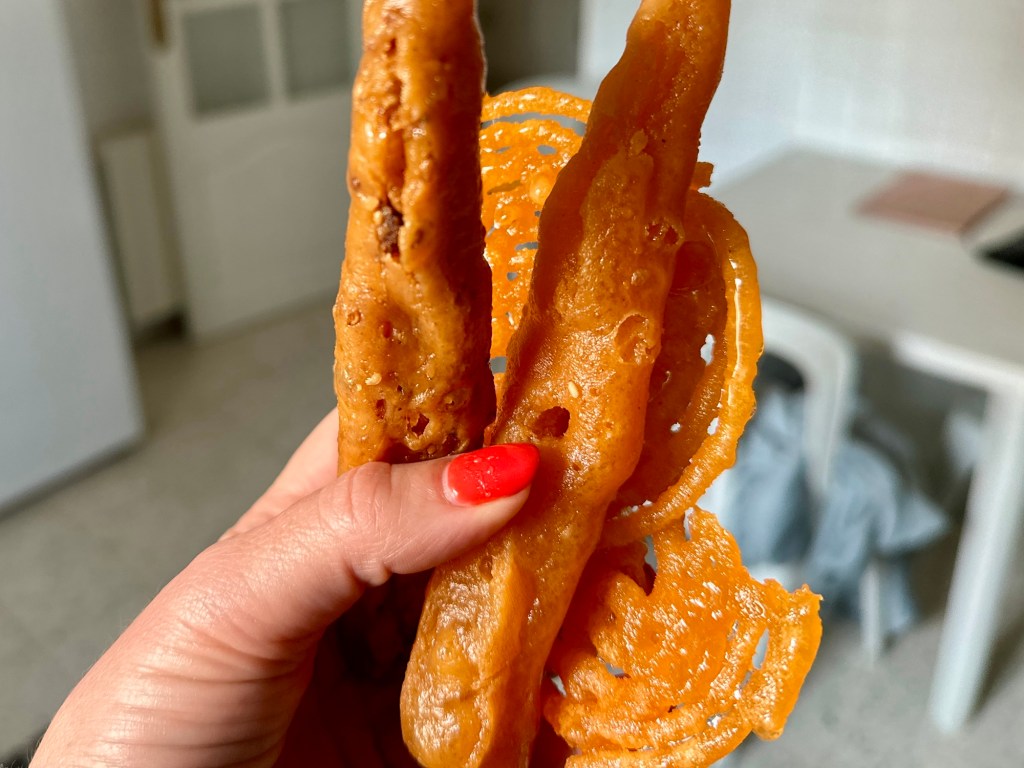
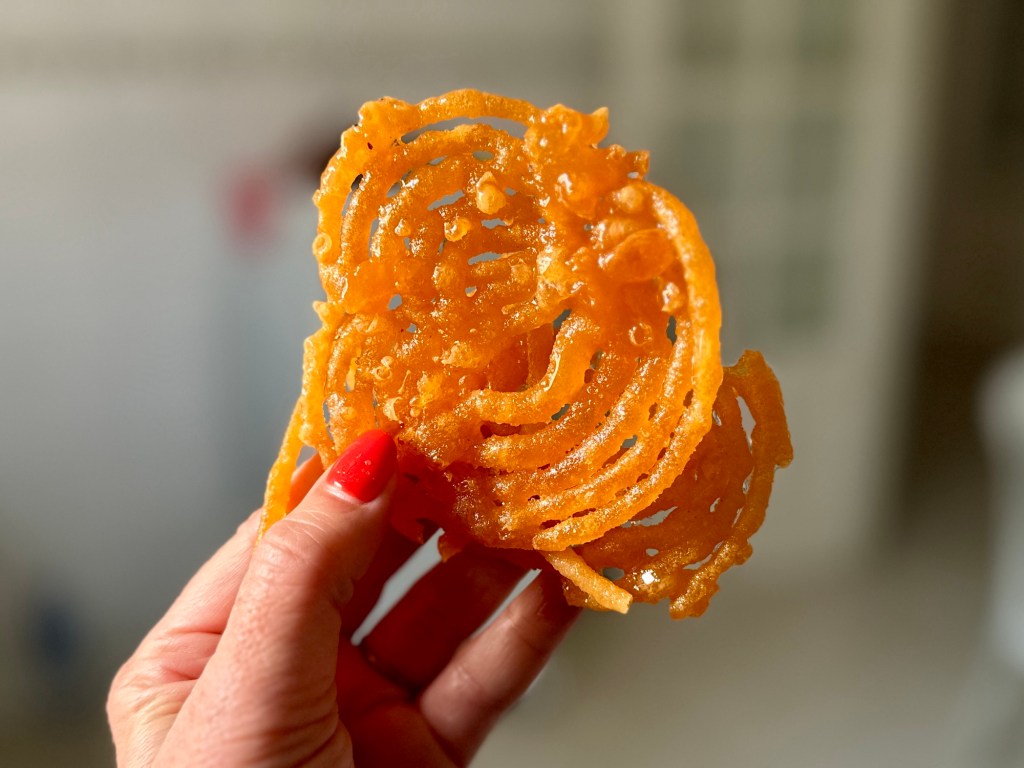
Ingredients: fried dough, sugar, cinnamon, honey, rose water, anise seed
Spice level: zero
Average cost: 1-2 TND
Best place to try it: Kairouan
16. Kaak Warqa
Kaak Warqa (pron: Kack-Warr-Kah) are Tunisian cookies that are generally found in the medinas during Ramadan. They are made with almond flour and scented with rosewater.
Kaak Warqa originates from Andalusia in Spain. The legend is that when the Andalusians were kicked out of Southern Spain, they baked small donuts and hid their jewels inside. These Andalusians landed in the Zaghouan region of Tunisia, and several generations later, their ancestors baked these cookies to honor their family’s journey. The almond paste represents the jewels that were once hidden inside.
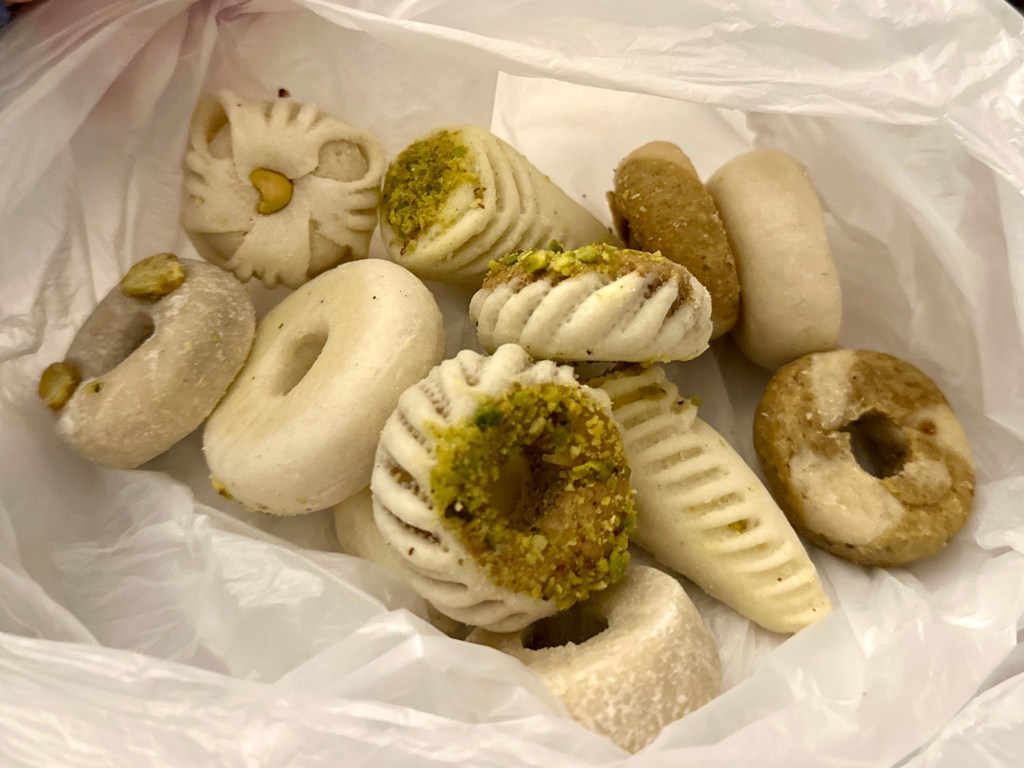
Ingredients: sugar, rose water
Spice level: zero
Average cost: 5 TND (for a small bag, like the photo above)
Best place to try it: Any Medina
17. Mint Tea
Mint tea is common amongst all countries of the Maghreb, including Tunisia, as a result of the Ottoman Empire’s influence of the region. You can find mint tea in all corners of Tunisia, including rooftop cafes in Tunis, shisha bars in Tozeur, ribat cafes in Hammamet, etc.
The unique thing about tea in Tunisia is that it is often served with a side of nuts- almonds, cashews, etc. Drop the nuts in your hot tea and allow them to sit at the bottom of the cup while you sip. Once you finish the tea, you have a tea-infused nutty snack to eat. Tunisian mint tea is often very sweet, and it is hard to find non-sweetened tea, as it is made in large batches.
Mint tea is a symbol of hospitality. You might be offered tea while shopping in the medina, checking in to a hotel, or being greeted into someone’s home.



Ingredients: black tea, mint, almonds, other nuts
Spice level: zero
Average cost: 3-7 TND
Best place to try it: Anywhere in Tunisia
18. Pomegranate Juice
Pomegranates grow across Tunisia, though the most famous city for this fruit is in Testour, which is also known for its homemade cheese and butter. I had several glasses of pomegranate juice while visiting Testour on our one-week road trip throughout Tunisia.
This red fruit originates in Persia but was traded throughout the Mediterranean region. It was once known as the “Chinese Apple.” When the Roman soldiers first came to Carthage (modern-day Tunis), they saw the pomegranate for the first time and called it malum punicum, the “Punic apple.”



Ingredients: pomegranates
Spice level: zero
Average cost: 3 TND
The best place to try it: Testour
Best Time To Visit Tunisia
The most popular times to visit Tunisia are the summer months of June, July, and August. They are also the hottest months as well. This is when tourism levels will be higher, as will the prices. However, if you’re looking for an alternative to a European beach holiday, Tunisia could be exactly what you’re looking for. There are a ton of great towns along Tunisia’s coastline such as Hammamet, Mahdia, Sousse, and Monastir.
I spent two months in Tunisia, from early February to mid-April. During that period of time, I watched as the weather turned from a very mild winter to a warm and burgeoning spring. I only needed a light jacket during the first few weeks but it was easily shorts-season by the time I left. February is known to be one of the rainiest months, so a good rain jacket is a great item to pack if you’re planning to go around that time.
The winter months are not the best for a beach holiday, but they are the best for traveling around the country. Prices will be much lower, and you can even bargain down prices at some hotels when you walk in, as there aren’t a ton of other tourists at this time. During our one-week road trip around Tunisia in late February, we didn’t see a single other tourist, which made interacting with the locals very fun and authentic.
Tunisian Street Food FAQs
Have you perused all of these 18 best Tunisian foods and still have some questions? Well don’t worry, I’ve got some answers. After two months in Tunisia, I became very familiar with these foods.
What is the most popular food in Tunisia?
The most famous dish that Tunisia is known for is couscous. It has a long history in the region, as it originates with the nomadic Berber tribes who collected and stored grain. It is a dish that can be easily made at home, or found at any street food stall. It’s very affordable and can be altered depending on the type of meat or vegetables that are cooked with it.
What do Tunisians have for breakfast?
Like many cultures, there is some variety in the breakfast options. One of the more common breakfast foods in Tunisia is a porridge called droô, which is especially consumed during Ramadan (before the sun rises). Droô is made from sorghum flour, milk, and sugar, and is often served with dried fruits and sesame seeds.
Similar to droô is another porridge, or paste, called bsissa, which is made from crushed cereals and mixed with olive oil or honey, and dried fruit on top.
As in most of the Maghreb and the wider Arabic community, dried fruits such as dates and chriha (dried figs) are very commonly eaten in the morning with bread and olive oil.
On the sweeter side of breakfast, Tunisians also eat assida bidha (thick semolina cream covered in honey) and Ftayer (fried donuts with sugar).
What is Tunisia’s best dish?
The answer to this is really subjective. The most famous Tunisian food is couscous. The food that made the TasteAtlas Top 100 Salads list is salade mechouia. I personally love kafteji, and even more in sandwich form. Tunisians know how to do street food right, so there are a ton of easy handheld food options like kafteji or lablebi sandwiches, mlawi, baguette farcie, chevrette sandwiches, etc.
Is it cheap to eat in Tunisia?
Eating street food in Tunisia is a very fun, and very affordable endeavor. You can easily eat all 3 meals for $10-12/day. That said, eating at tourist restaurants will bring a much higher price for the same item. For example, salade mechouia at Café des Délices in Sidi Bou Said costs 28 TND (9 USD), whereas the price of the same dish at a food stand in La Marsa will cost 6 TND (2 USD).
Final Thoughts on Tunisia’s Street Food
One of my favorite things about travel is trying the local food, especially the street food. Tunisia gave me lots of opportunities to do just that. Finding a new food was really excited and I wanted to try as much as I could.
My favorite thing about Tunisian food is the spiciness, which I’m a big fan of. That said, they do usually ask if you want your food picant (spicy) or not, allowing you to dictate how much harissa gets added.
I hope this article about Tunisia’s best street foods has inspired a visit to this lesser-known country in North Africa that is sure to win your heart.
Pin these photos to Pinterest for future reference.



TRAVELING SOON?
INSURANCE: Cover yourself with travel medical insurance by SafetyWing.
FLIGHTS: Get the best flight deals with Skyscanner and set flight alerts with Hopper.
STAYS: Check out hotels and apartments with Booking.com and Vrbo.
RENTAL CARS: Get the best deal on rental cars with Discover Cars or RentalCars.
GOING HIKING? Get a 30% discount off your yearly AllTrails+ Account (code: nickiposts30)
eSIM: Get an international eSim with Airalo or eSimple.
CITY GUIDES: Save time and purchase pre-made city guides with Thatch.
CITY TOURS: Book your tour with GetYourGuide and Viator
LUGGAGE: Get the best carry-on suitcase here.
CREDIT CARD: Start earning travel points with the best travel credit card.
BUENOS AIRES GUIDE: Purchase my Buenos Aires travel companion here.
CONSULTATION: Book a 1:1 travel consultation with Nicki here.
SUBSCRIBE: Get the Nicki Posts Travel Stuff newsletter every month.
You must be logged in to post a comment.